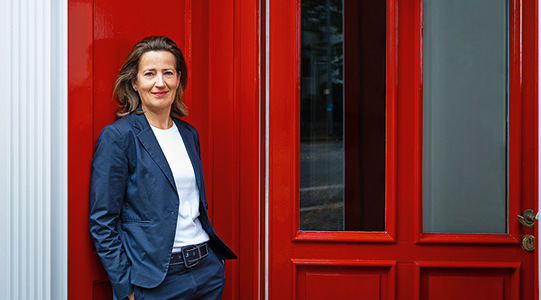
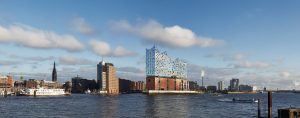
Dorotheum expands in Germany: in addition to the branches in Düsseldorf and Munich, Dorotheum is pleased to announce the opening of a new office Hamburg. Clients now also have the new northern German office at their disposal for advice on selling works of art and collectables, and for viewing selected highlights coming up for sale. Join the Director of Dorotheum Germany, Katharina zu Sayn-Wittgenstein, on a stroll around the Hanseatic city.
“For my taste, when you take the location, the Elbeand the Alster together, Hamburg is Germany’s most beautiful city.” This quote by fashion designer, and incidentally photographer, Karl Lagerfeld is one of the first things to greet you on arrival at Hamburg Airport.
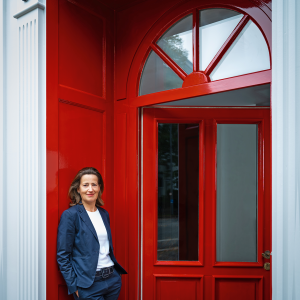
the new Dorotheum branch.
photo: Bertold Fabricius
For me, it’s the water and the light. The fact that a city can be built out of these two elements fascinates me. And it is also a city that is green by its very nature as well. I don’t know any other city like Hamburg: urban life with the highest quality of living. Karl Lagerfeld, who was himself Hanseatic, said of his native city: “Hamburg is the gateway to the world. But only the gateway …” – you can either be amused at his quip or you take exception to it – come and decide for yourself!
Water and light are the essence of life, and not only in the context of art. The city of Hamburg lives by them. Its port, the third largest in Europe, is anchorage for the soul. Anyone who takes a tour of Hamburg’s harbour on the Elbe (departure St. Pauli jetty) – a great experience for tourists and locals alike – will learn a great deal about the “engine room” of the city. There is the Free Port with its imposing red-brick wharf area, redolent with the aroma of coffee and spices, its warehouses – the legacy of the entrepreneurs of the past, known as Pfeffersäcke (pepper sacks), who once accumulated immense wealth on this site – now inhabited by the offices of modern start-ups and agencies. At these docks, thousands and thousands of containers are loaded and unloaded, twenty-four hours a day. An excellent vantage point from which to view all this activity is the legendary waterside bar, the Strandperle, where your feet play in the sand and your mind is borne away to a life of luxury on the cruiseship MS Europa as you watch it steam in and out. If you are really setting sail along the Elbe towards the North Sea, take a look at the right-hand bank of the river. There, you will glimpse the poetic side of this mercantile metropolis: the chic villas of the Treppenviertel in the fashionable suburb of Blankenese, climbing up the stepped hillside, reminiscent of an Italian mirage, found here in the far away North.
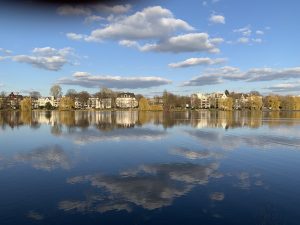
photo: KSW
Water and light … Hamburg is, allegedly, the capital city for skilovers in Germany (there are even school holidays for skiing), but in reality it is water sport that reigns supreme in Hamburg, as illustrated by the countless rowers, sailors and stand-up paddlers to be found on the Alster and its canals. Apparently, there are more bridges here than in Venice. In spring, the banks of the Alster are a sea of daffodils and crocuses; in May – parallel to the famous Japanese festival of the same name – the river banks are transformed into a magical cloud of cherry blossoms. Tips for the Alster: coffee and cake on Bodo’s Bootssteg (Bodo’s Jetty), where you can hire a wooden Alsterjolle (Alster skiff ) and take to the water; the “Cliff ” for breakfast, directly on the waterfront, where you can hang out all day and then enjoy a last drink as the sun goes down; and the Alsterperle (Alster pearl), from which you can enjoy a view of the inner city and the unforgettable light play on the façade of Hamburg’s concert hall, the Elbphilharmonie.
The extraordinary concert hall, the “Elphi”, as the people of Hamburg call it, dominates the view when you arrive by train or by air. It was created by renowned architects Herzog & de Meuron and was initially highly controversial on account of its astronomical building costs. Now, it pulsates as the very heart of culture lovers, national and international, who come from far and wide to enjoy the performances of stars from all over the world. Hamburg was, and still is, a city of music: Telemann, Bach, Mendelssohn, Brahms and Mahler have left their traces here. And it is not just musicians of the past who made their mark: The singer and panic rocker, Udo Lindenberg, who resides in Hamburg’s legendary Hotel Atlantic, has recently been awarded Honorary Citizenship of Hamburg, the second musician to be honoured this way after Johannes Brahms.
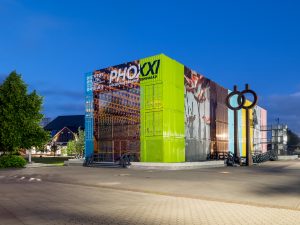
for the Haus der Photographie
photo: Henning Rogge/Deichtorhallen
People in Hamburg say: “There’s no such thing as bad weather, just the wrong clothing.” In case you are caught out by the weather, you might want go to one of my favourite museums. The most wonderful photographic exhibitions are usually to be seen in the Deichtorhallen art centre. Unfortunately, its Haus der Photographie is currently closed for refurbishment until 2025. However there is an alternative I would suggest which is nothing, if not original: a container building by the name of PHOXXI. Its intensely coloured façade was created by the artist Anselm Reyle, who, amongst other elements, used works by the iconic Hamburg photographer, the late F. C. Gundlach in his composition. The collector Harald Falckenburg, a native of Hamburg, is a driving force behind the contemporary art scene in the city, and his permanent loans to the Phoenix Hallen in Hamburg-Harburg provide envigorating art experiences. We are inspired by the work of the MK&G (Museum of Arts and Crafts, Hamburg), whose visionary approach fosters interaction with real life, thus breaking with the tradition of the museum as a classical temple of culture. An institution which reflects all centuries and at the same time connects to our life today is Hamburg Kunsthalle, whose architecture is also a feast for the eye. Situated opposite the historic red-brick building is the Gallery of Contemporary Art, a white cube constructed by Oswald Mathias Unger. Visits to the variously themed exhibitions in the Bucerius Kunst Forum near the Town Hall are especially rewarding. There are of course many commercial galleries in Hamburg; the hub of the scene is on Admiralitätstraße on the Fleetinsel, which is always worth exploring.
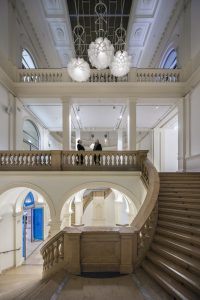
by DRIFT at MK&G
photo: Henning Rogge
Many cultural institutions are embedded in their surrounding districts which is somehow reminiscent of Paris or London and other European capitals. This is the secret of the city’s charm: street cafés under lime trees (in Eppendorf, Ottensen), coffee roasting houses, boutiques, bookshops (e.g. Felix Jud), also high-end haut-couture shops (Neuer Wall).
Hamburg is also a city of sensual pleasures, and I do not only mean those associated with the notorious red-light district of the Reeperbahn. There is also a seemingly inexhaustible selection of creative culinary experiences to choose from in this town, kicking-off with the Fish Market (there is much fun to be had here on Sundays starting at five o’clock in the morning) and including the weekly markets. One of the best is the Ise Market in the suburb of Eppendorf, stretching a kilometre or so under the raised tracks of the U-Bahn. It is a veritable institution for conviviality and shopping, focused on food, household and cooking. It is renowned as one of the largest and most charming weekly markets in Germany. My hot tip and favourite stall at the market: Kräuter Malte who has fresh mint and organic Amalfi lemons amongst his wares. Hamburg is also unbeatable in the field of gastronomy: Chefs like Tim Mälzer, Cornelia Poletto and Steffen Hensser don’t just talk about great cooking on TV – they also really deliver in their restaurants around town. For discerning gourmands, even more “gastronauts” include star chefs Kevin Fehling at The Table, Maurizio Oster at Zeik, Matteo Ferrantino at Bianc and Wahabi Nouri from Piment.
So that is Hamburg. And now, this autumn, right at its heart, Dorotheum is opening an office for you. We look forward to welcoming you aboard!
Author: Katharina zu Sayn-Wittgenstein is an art historian and was the founding director of the Mucha Museum in Prague and most recently headed Sotheby’s branches in Hamburg and Munich. Since autumn 2022, she has been Head of Dorotheum Germany and director of the Hamburg office.













